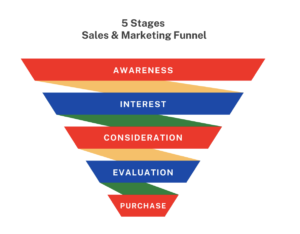When planning content for a website, the main goal of a business is to offer users a satisfying experience. If the user has typed a query into Google, it’s because they are looking for an answer to a question. You can offer that answer. But if the goal stops at giving answers to a query, most of today’s businesses would be bankrupt. The goal should be double: bringing people in using SEO tactics and encouraging them to do something using CRO. Still, today, too many people and companies think that SEO and CRO are two separate things. In this article, I’ll show you why SEO and CRO should go hand-in-hand, how they work together to drive results and what are some of the things to do (and don’t do) to make sure this happens.
In this article, we will cover the following topics:
- What is SEO? What is CRO?
- Why SEO and CRO should work together
- What’s the impact of CRO on SEO and vice versa
What is SEO?
We all know what SEO is, don’t we? If we stick to the definition, Search Engine Optimization works on optimization to make sure a website or a single page ranks on top of search engines’ organic results. When your website ranks at the top of search results for a specific set of keywords, all the people searching for a particular keyword within that set will find your pages and visit them. SEO has changed a lot over the years. Today, aside from the technical optimization and continued improvement from a technical standpoint, it heavily means taking care of users’ needs and addressing them. The query’s search intent and user behavior play a considerable role, and more than ever, they’re prioritized over everything else. It means designing the architecture of your website considering your target’s behavior and search habits, creating country-specific content that your audience wishes to consume, constantly analyzing customer analytics, retention and lifetime value to unlock hidden content opportunities that traditional keyword research otherwise fails to detect. But it also means optimizing your entire online presence and how each channel interacts with each other on SERP.
Your final goal is to generate ROI. Today, SEO generates ROI only if it focuses on attracting new users and allowing them to benefit from your content and your offer.
What is CRO?
CRO, Conversion Rate Optimization, is the process of testing elements, CTA, and designs to earn more conversions for your business. A conversion is why pages on the web exist, and it’s part of the overall marketing/business strategy to reach a specific goal within a certain timeframe. If we want to simplify it, conversion is an action performed by a user on a web page after having landed on that page: it can be improving subscriptions to a newsletter, activating a free trial, completing a purchase, and so on. Every business and organization defines what conversions mean to them.
We can use a simple yet effective formula to calculate the conversion rate: dividing the number of conversions by the number of visitors to a specific page and multiplying the result by 100 to get a percentage.
Let me be practical:
If your page had 3300 visitors last month and 123 people subscribed to your newsletter, your conversion is the result of this formula:
123/3300×100=3.72%
What does this number tell you? Well, very little in all fairness: it’s a number. To make sense of it, you need to understand your conversion goal (checkout completion is different from subscribing to a newsletter) and your users, which may differ from the users you’re attracting from other pages.
There’s more to CRO than this: if we only define Conversion Rate Optimization using percentages, averages, and benchmarks, we’re missing a big piece of the puzzle. What’s the risk of using a cold formula to understand your conversion rate? The most significant risk is becoming obsessed with the percentage you get and trying thousands of different ways to boost that number randomly.
Nowadays, CRO is more trying to understand what drives and persuades your potential users so that you can give them the best user experience possible: think about using a specific jargon based on their location, culturally relevant elements that make them feel at home, references to things they know and embrace or simply encourage them to click on a button that has been strategically placed within the page and speaks directly to them. At the same time, also think about the barriers that may make them leave before arriving at the actual converting piece.
When you’re working to improve conversions, your final goal to improve your conversions rate is an in-depth understanding of what matters to your users.
SEO and CRO: A match made in heaven
Don’t you already see the connection between SEO and CRO? Rethink everything you’ve read so far, and it should already be clear: if your SEO goal is solely to rank, you’re doing SEO wrong, and if you’re testing ways to convert more without thinking about the ranking of your page and the target user, you are doing CRO wrong. A massive conversion rate is useless if hardly anyone visits the site, and traffic is useless if it doesn’t bring ROI.
If you’re not thinking clearly about search intent (for SEO) and user behavior (for CRO), you’re wasting your time and resources, becoming the hamster on a wheel that never stops.
SEO focuses on boosting traffic to a site. CRO aims to convert that traffic by encouraging more people to take action.
Have you ever landed on an article on a blog after searching on Google for a specific topic, and, as soon as you’ve reached the end of the article, a box to subscribe to a newsletter appeared, prompting you to subscribe to get similar pieces in your inbox? Have you ever checked a landing page you’ve found via Google and bought the product suggested on that landing page since it answered your needs? These are two easy examples of what bringing traffic and converting that traffic means, and this is how SEO and CRO work together.
If SEO takes charge of bringing people in, CRO takes charge of retaining them and making them do something: SEO stimulates and fulfills a need in its infancy, CRO makes sure that the needs are satisfied, enticing users to take action.
Let’s have a look at the (in)famous yet very useful purchase/marketing funnel to understand how these two tactics work together to get results:

SEO is usually used as a vehicle to drive awareness. If your content ranks high for specific keywords, more people will visit your website, and they will (hopefully) start their journey with your organization. SEO fuels the marketing funnel with volumes of potential buyers.
On the other side, CRO helps transform these potential buyers into actual ones by providing them with tools to evaluate and decide what to do after landing on a website.
SEO works top of the funnel, and CRO works bottom of the funnel; together, they work in the middle of the funnel. Suppose someone lands on a page from Google, and they don’t find the information they were supposed to see. In that case, SEO and CRO haven’t done a good job: SEO has promised something that is not there, and CRO hasn’t fuelled users’ interest in doing something to get actual results.
[Case Study] Optimize links to improve pages with the greatest ROI
SEO and CRO: The do and don’ts
So far, so good: you now know the difference between SEO and CRO and why these tactics should always work together to deliver results. But in digital marketing, we are all a bit obsessed with finding and using best practices thinking that if something has always worked and worked for someone else, it will also work for you. Let me give you the bad news: blindly applying existing best practices does not guarantee success, but it does keep you playing cat and mouse games. While other companies are experimenting and progressing, you’re just stalling and waiting for results to come. And they may never come.
Over the years, people working in CROs have used and overused the following “best practices”, thinking that they always guarantee an increase in conversion rate from people arriving on a website via SEO:
– Using a vividly colored button for your CTA and making it bigger than anything else;
– Adding your CTA above the fold
– Adding social proofs and testimonials
– Making your web forms shorter
There’s no proof that these tactics work and will never work. Do you know why? They’re cold and don’t consider the users. Instead, they appeal to the famous “one size fits all” approach that barely and rarely works these days. On top of this, they are rushed: since they work for someone else, they have to work for me.
There is only one principle that is always valid, and it works both for SEO and CRO, and it’s the only one you need to follow: understand your target and build a culture around your obsession. You want to attract and convert people that matter to your business, and to do so, you need to know what they need, how they behave online, what are their main concerns and act accordingly, delivering a final product of which they want to avail. The quality of your traffic and your conversions is more important than the quantity; that’s why users have to be your focus when creating SEO pages and when optimizing them for CRO.
Let me explain; say you have to optimize a landing page. The SEO team decides to focus on a set of keywords that don’t appeal to the potential customers, but have huge volumes. The CRO team, from its side, decides just to add buttons here and there, following the same approach used for other pages, without thinking about the potential customers’ behavior and interests. The results: no relevant traffic, no conversions. The page may rank high on Google and attract a lot of traffic, but since this traffic is not relevant to your business and the stimulus to act is not appealing to them, they will leave.
These are some of the things you may want to do to take advantage of both SEO and CRO in order to up your game:
Create relevant content with a solid and clear search intent
I’m not explaining which elements Google uses to rank pages. We all know that Google always wants to display results that answer specific queries and provide a great user experience. To win with Google and users, you need to create content that matches search intent, answers a question, and provides users with all the information.
Track page speed and bounce rate
Both page speed and bounce rate are crucial for SEO and CRO. Improving page speed can help a page rank in a better position and, at the same time, can help CRO allowing people to navigate a page with ease. Now suppose your bounce rate is too high. In that case, it means that users landed on your website and then realized it wasn’t a good fit for them: SEO has to take care of targeting the right people to avoid bounce rate, but at the same time, CRO has to make sure that people landing on a page are prompted to complete an action.
Take advantage of frictions
By definition, frictions are all those elements that can discourage a user from doing something on a website. It’s a common conception that one of the most significant types of friction is having a banner that interrupts the reader to ask them to subscribe to a newsletter. The truth is that even if you’re interrupting the user experience, you’re allowing them to take advantage of something exactly when they’re thinking about a solution to a problem that can occur in many different ways.
Every article on the Hubspot blog includes a banner right after a crucial explanation or solution to a problem: does it interrupt the reading experience? No, because it’s contextually providing the key to a problem and triggers users’ need to avail more advice without needing to search for it.
Identify where people leave your website
Why do people leave a page? Suppose the topic is relevant to them and the content is appropriate. In that case, they may leave because the content is too repetitive or too thin; there’s nothing they’re taking away from it; perhaps because SEO and CRO are not going in the same direction (SEO addressing one intent, CRO suggesting solutions for another purpose); or they have already learned everything they needed to know in the first lines and don’t see a reason to keep going. If you can find all the pages where you lose most visitors, you can start planning for better optimization.
How? SEO may identify peripheral intent keywords that keep the user engaged and, with the help of the editorial team, rewrite the content and make sure that the users have all the content they need to learn everything about that specific topic. And at the same time, CRO may want to rethink the CTA, both in terms of design, wording, and overall conversion goal.
Leverage data
Usually, CROs and SEOs use different data to make decisions and very often, they think that they don’t have to care about other metrics. The issue with this is clear: when we work in silos, we miss the big picture, and this is even more true based on what I’ve explained to you so far when it comes to SEO and CRO. Traffic is nothing without conversions; conversions are not possible without traffic. Customer insights from conversion rates can help SEOs target the right people; insights on search intent can help CROs suggest the best solution to convert those users.
[Case Study] Refine your SEO strategy based on relevant data and granular segmentation
A/B test in tandem
One of SEO’s most significant and interesting parts is experimenting, and the same goes for CRO. If you start A/B testing in tandem with SEO and CRO, you can discover things you’ve never thought about: what happens if I begin targeting a user’s intent with SEO and then trigger a different need via CRO? Does the length of content influence conversion rate, ranking or both? Once you have the data sorted out and the strategy in place, testing your SEO and CRO efforts in tandem is the best way to make this marriage work.
Do CRO and SEO hurt each other?
At this stage, I’m sure you’ve been thinking, well, if I optimize for CRO and start adding elements to fuel conversions, doesn’t this hurt my SEO efforts? And what if I remove CRO elements because I need more space for my SEO items? There’s only one answer: it does when you don’t consider site speed and the overall information architecture. And it does when the two teams (when two teams exist), don’t communicate and instead work independently.
Imagine a situation like this: as part of a CRO optimization, the team decides to remove some piece of content from a few pages and add an image with a CTA. This copy was keyword-optimized and internally linked to key category pages; after the CRO optimization, the conversation rate improved, but the organic traffic decreased because the page speed got worse, the copy was important and provided necessary signals in terms of search intent.
But let’s also imagine a reversed situation: the SEO team decides to make changes to some pages, by removing CRO elements such as the box for subscribing to the newsletter, favoring a new SEO optimized heading and text. After the optimization, traffic and ranking increase, but the conversion rate decreases drastically because the new layout doesn’t fit users’ expectations and behavior.
These are just two easy and simplified examples, and even if we have to consider every situation as different from another, the bottom line is straightforward: SEO and CRO have to work together and consider both tactics when making changes to a website is vital to make sure they don’t hurt each other. How? Knowing their goals, who are their users and testing possible solutions to deliver the best results.
A final piece of advice: remember that both conversion rate and SEO optimization are iterative processes. Once you think you’re done, it’s time to start again from scratch because every opportunity hides more opportunities, and your final goal should be not to miss any.
I hope this guide has been helpful and that you’ve seen the benefits of SEO and CRO working together (and perhaps being part of the same team or being the same people). If you have any questions or want to connect and chit-chat about SEO (and pizza), follow me on LinkedIn and/or Twitter and send me a DM.

